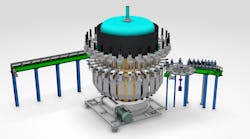The world of making is changing, and businesses are digitally transforming from mass production to mass customization as consumers demand individualized, emotional experiences. New technologies such as 3D printing, artificial intelligence (AI), and the Internet of Things (IoT) are starting to significantly impact how products or experiences are designed and manufactured. Meanwhile, social apps, Big Data, and the Cloud are creating opportunities to interact with and understand the consumer in totally new ways. So how do we bring these new data streams and technologies together to produce meaningful business insights?
The key to leveraging the power of these new technologies and the data they generate is finding a way to connect individuals, machines, and processes across the entire manufacturing supply chain, which can now reach from raw materials to consumer interaction. This broader expanse requires shifting away from a linear supply chain to a dynamic network, which enables synchronization and integration of all manufacturing operations and supply chain activities. Achieving this requires digitalization of information and a platform that enables this level of collaboration.
Software solutions implemented within the last decade simply are not up to the task of handling this level of integration, nor the plethora of data now being created. Rather than investing in the new, many companies try overhauling the old by stringing together point solutions, hoping they gain some efficiencies. With today’s pace of technological change, incremental improvements to business processes are not enough to achieve the speed and responsiveness needed. It requires an entirely new way of doing business.
Case in point: a recent McKinsey study found that across all industries, executives identified a need for dramatic improvements in particular software applications, citing dissatisfaction with certain CAD, Enterprise, resource planning (ERP), and manufacturing execution systems (MES) solutions. Among complaints was the fact that some systems are closed—they don’t communicate with each other or allow others to build upon them. Yet, the key to a dynamic supply chain is a successful digital manufacturing strategy, which requires fluid digital communication.
Digital Continuity from Concept to Purchase
Virtual assembly line component.
The concept of digital continuity begins with a digital thread. Since products are virtually designed and engineered in 3D, this data can then be used to verify all products and before any production begins. Today, various areas of a manufacturing enterprise may be digitalized and connected, but not fully integrated into a single product or system. But the notion of digital continuity is defeated if key steps along the way aren’t integrated.
For the supply chain to function dynamically, manufacturers need to extend this digital thread beyond the start of production, including integrating feedback from the plant floor, the supply chain, the distribution network, and even consumers offer feedback into the models for improvement. Creating a virtual model linking disparate systems and processes across all departments and functions within the value chain is required. This means there must be integration between product life-cycle management (PLM), ERP, shop floor applications, and equipment to enable the exchange of product-related and process information between the virtual and the actual, physical manufacturing execution, creating digital continuity.
The virtual model also includes the representation of manufacturing operations management solutions. This monitors daily activity, connecting people and machines on the plant floor, assigning tasks, and ensuring proper parts and materials are in place. It communicates material requirements back up the supply chain. Going forward, it has the potential to employ AI to review production data and correlate that with other factors, such as weather changes or supply changes, which could potentially impact delivery or production.
Another related area of manufacturing involves supply chain planning and operations tools that enable manufacturers to decide how much capacity they need and where they need it. They can improve their visibility into a global manufacturing and supply chain footprint and better synchronize it, eliminating bottlenecks through the entire value chain by matching supply and demand efficiently.
To meet new consumer expectations and realize cost savings, manufacturers need to establish more than a digital thread. Digital continuity is needed to provide the formal digital framework for information exchange throughout the manufacturing process as well as feeding a new dynamic supply chain. This requires an infrastructure built upon a platform that is flexible enough to integrate various IT applications. This platformization can achieve a “single source of truth” that provides a federated and dynamic view of models, processes, operations, and planning optimization across the supply chain.
This level of connection and data synchronization will help to realize the power of today’s emerging technologies, helping manufacturers gain the insight to make actionable decisions to optimize operations while delivering a better consumer experience.
Eric Green is VP of User Experience, Advocacy, & Marketing at DELMIA, Dassault Systèmes.










